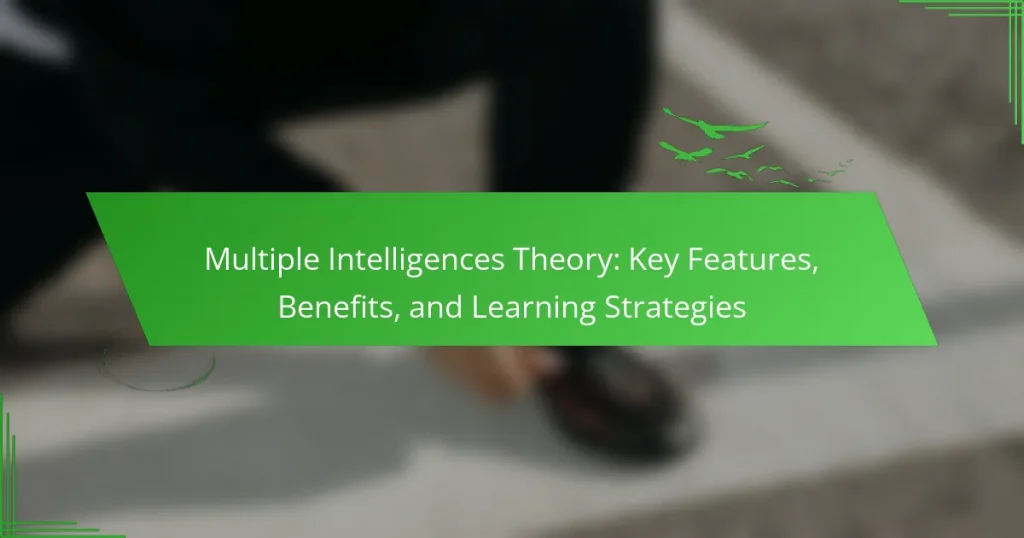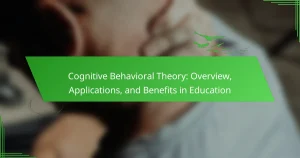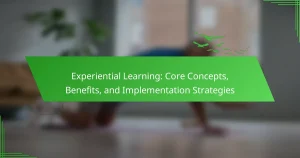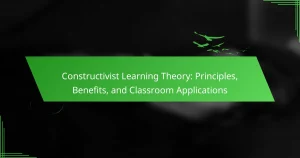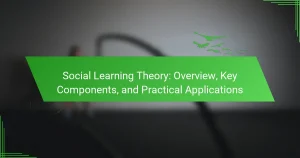Understanding Multiple Intelligences Theory can enhance educational outcomes by recognising diverse cognitive abilities. This article explores its key features, including the eight distinct intelligences, benefits like improved engagement, and effective learning strategies tailored to individual strengths. It also examines the integration of emotional intelligence and cultural specificity in educational practices, along with future trends in personalised learning and technology use.
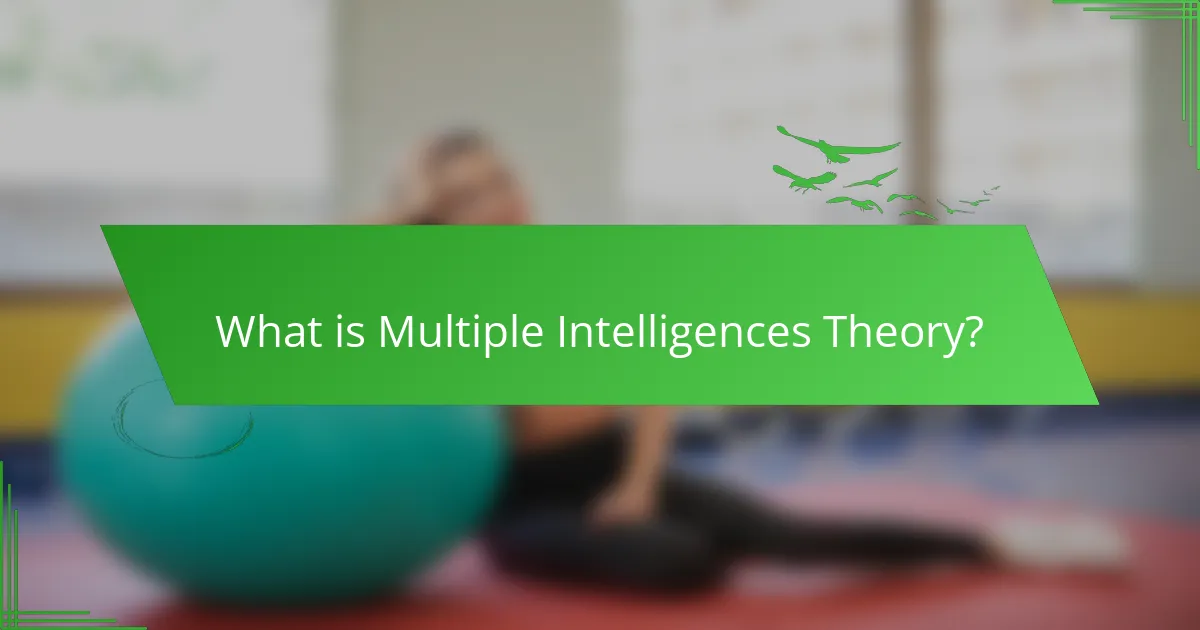
What is Multiple Intelligences Theory?
Multiple Intelligences Theory posits that individuals possess various types of intelligences beyond traditional academic skills. This theory, developed by Howard Gardner, identifies eight distinct intelligences, including linguistic, logical-mathematical, and spatial. Understanding these intelligences enables tailored learning strategies, enhancing educational outcomes. Benefits include improved engagement, personalised learning experiences, and recognition of diverse talents. For example, a student strong in musical intelligence may excel through rhythm and sound, while another may thrive in interpersonal settings, showcasing the unique attributes of each intelligence.
Who proposed the Multiple Intelligences Theory?
The Multiple Intelligences Theory was proposed by Howard Gardner in 1983. This theory identifies various types of intelligence, expanding the traditional view of intelligence as a single entity. Gardner’s framework includes eight distinct intelligences, such as linguistic, logical-mathematical, and musical intelligences, emphasising the diverse capabilities of individuals. This approach has influenced educational practices by promoting personalised learning strategies that cater to different strengths.
What are the key features of Multiple Intelligences Theory?
Multiple Intelligences Theory emphasises diverse cognitive abilities beyond traditional IQ. Key features include eight distinct intelligences: linguistic, logical-mathematical, spatial, musical, bodily-kinesthetic, interpersonal, intrapersonal, and naturalistic. Each intelligence represents unique ways of processing information and learning. This theory supports personalised education, allowing strategies tailored to individual strengths. By recognising these intelligences, educators can foster a more inclusive and effective learning environment, enhancing student engagement and achievement.
How does Multiple Intelligences Theory differ from traditional IQ testing?
Multiple Intelligences Theory emphasises diverse cognitive strengths, while traditional IQ testing focuses on a narrow range of analytical skills. This approach recognises various intelligences, such as linguistic, logical-mathematical, and interpersonal, promoting individualised learning strategies. In contrast, IQ tests often overlook unique attributes, reducing complex human intelligence to a single score. As a result, Multiple Intelligences Theory fosters a more holistic understanding of learning potential.
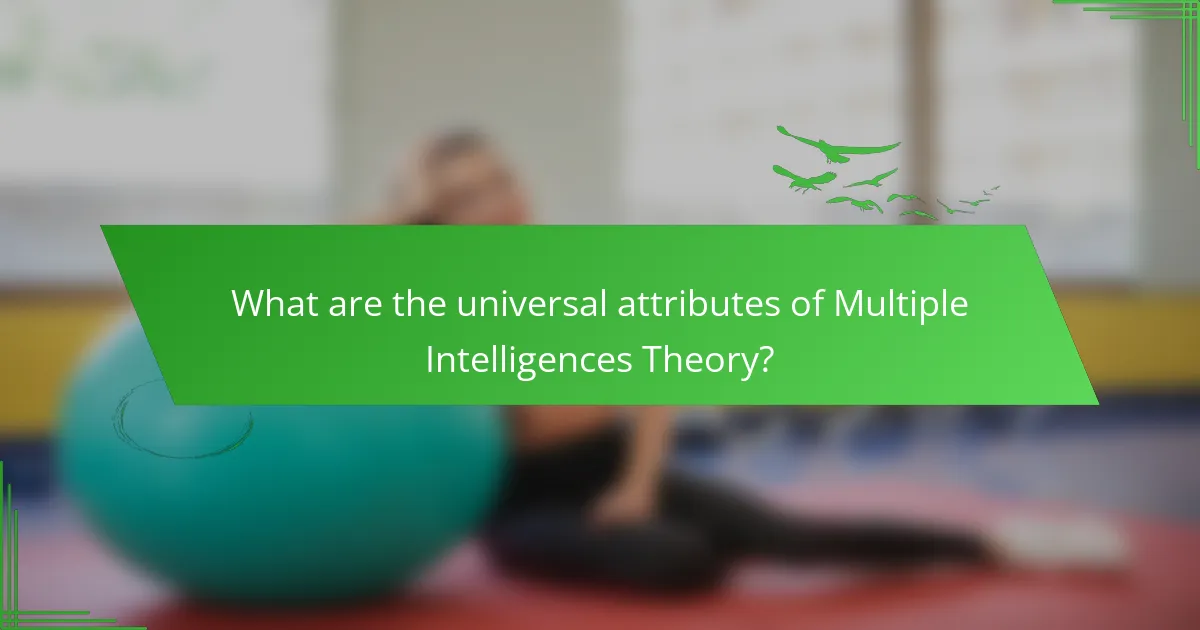
What are the universal attributes of Multiple Intelligences Theory?
The universal attributes of Multiple Intelligences Theory include the recognition of diverse cognitive abilities, the emphasis on individualised learning, and the integration of various intelligences into educational practices. This theory highlights eight distinct intelligences: linguistic, logical-mathematical, spatial, musical, bodily-kinesthetic, interpersonal, intrapersonal, and naturalistic. Each intelligence offers unique benefits, such as enhancing problem-solving skills and fostering creativity. Understanding these attributes allows educators to tailor learning strategies that cater to individual strengths and preferences, promoting a more inclusive educational environment.
What are the eight types of intelligence defined in the theory?
The eight types of intelligence defined in the theory are linguistic, logical-mathematical, spatial, musical, bodily-kinesthetic, interpersonal, intrapersonal, and naturalistic. Each type represents a unique way individuals process information and interact with the world. Understanding these intelligences can enhance personalised learning strategies and foster diverse educational approaches.
How does Multiple Intelligences Theory apply to diverse learning styles?
Multiple Intelligences Theory applies to diverse learning styles by recognising that individuals possess different types of intelligences, which influence how they learn best. This theory identifies eight intelligences, including linguistic, logical-mathematical, spatial, and interpersonal, among others. Understanding these intelligences allows educators to tailor their teaching strategies to meet the varied needs of students. For example, a student with strong spatial intelligence may benefit from visual aids and hands-on activities, while a linguistically inclined learner might excel through reading and writing tasks. By leveraging Multiple Intelligences Theory, educators can enhance engagement and improve learning outcomes for all students.
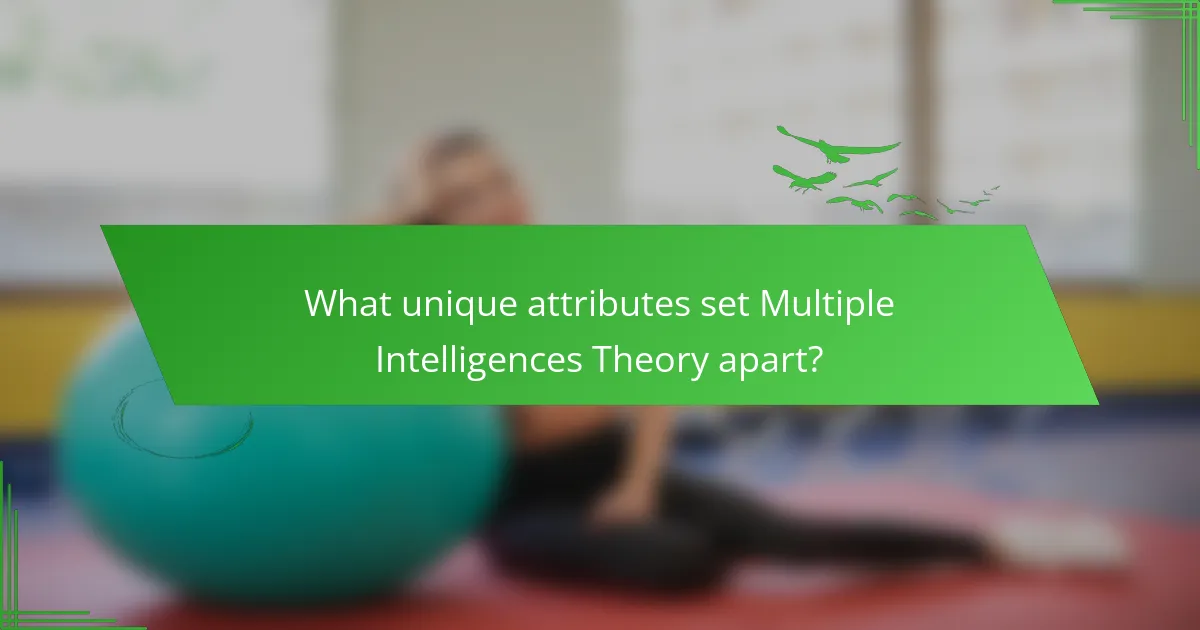
What unique attributes set Multiple Intelligences Theory apart?
Multiple Intelligences Theory is distinguished by its recognition of diverse cognitive strengths. Unique attributes include the identification of eight distinct intelligences, such as linguistic, logical-mathematical, and interpersonal. Each intelligence reflects different ways individuals process information and learn. This multifaceted approach allows for personalised learning strategies that cater to individual strengths, enhancing educational outcomes.
What role does cultural context play in Multiple Intelligences Theory?
Cultural context significantly influences Multiple Intelligences Theory by shaping how individuals perceive and express their intelligences. Different cultures prioritise various intelligences based on their values and social structures. For example, collectivist cultures may emphasise interpersonal intelligence, while individualistic cultures might value logical-mathematical intelligence. This variation highlights the unique attributes of intelligences as they manifest in diverse cultural settings. Understanding these differences can enhance educational strategies, making them more inclusive and effective across cultural boundaries.
How can Multiple Intelligences Theory be integrated into educational curricula?
Integrating Multiple Intelligences Theory into educational curricula enhances personalised learning. Teachers can tailor lessons to diverse intelligences, improving engagement and retention.
Practical strategies include:
1. **Varied Instructional Methods**: Use visual aids, music, and hands-on activities to cater to different intelligences.
2. **Collaborative Projects**: Encourage group work that allows students to leverage their strengths.
3. **Assessment Diversity**: Implement various assessment forms, such as presentations or portfolios, to evaluate understanding.
4. **Flexible Grouping**: Organise students into fluid groups based on their intelligence profiles for specific tasks.
This approach fosters an inclusive environment, accommodating unique learning preferences and promoting holistic development.
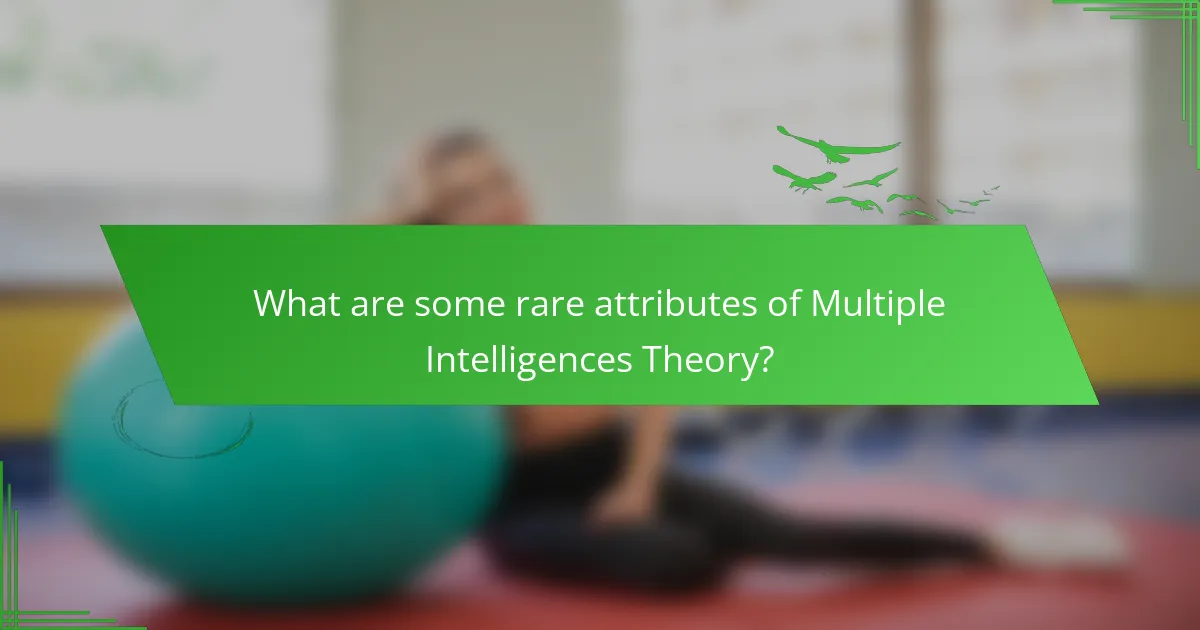
What are some rare attributes of Multiple Intelligences Theory?
Multiple Intelligences Theory includes rare attributes such as cultural specificity, which recognises that intelligence manifests differently across cultures. Another rare attribute is the integration of emotional intelligence, emphasising social skills and emotional awareness as part of cognitive capabilities. Additionally, the theory considers the influence of neurodiversity, acknowledging that variations in brain function can lead to unique intellectual strengths.
How does Multiple Intelligences Theory address emotional intelligence?
Multiple Intelligences Theory recognises emotional intelligence as a vital component of interpersonal and intrapersonal intelligence. It emphasises understanding and managing emotions to enhance learning and social interactions. This approach fosters self-awareness, empathy, and effective communication, which are essential for personal and academic success. By integrating emotional intelligence, educators can create tailored learning strategies that cater to diverse emotional needs, promoting a more inclusive and effective educational environment.
What are the implications of Multiple Intelligences Theory on gifted education?
Multiple Intelligences Theory significantly influences gifted education by promoting personalised learning approaches. It encourages educators to recognise diverse intelligences, such as linguistic, logical-mathematical, and interpersonal skills, tailoring instruction to individual strengths. This method enhances engagement, motivation, and academic performance among gifted students. By fostering a supportive environment that values different abilities, educators can nurture creativity and critical thinking, ultimately maximising each student’s potential.
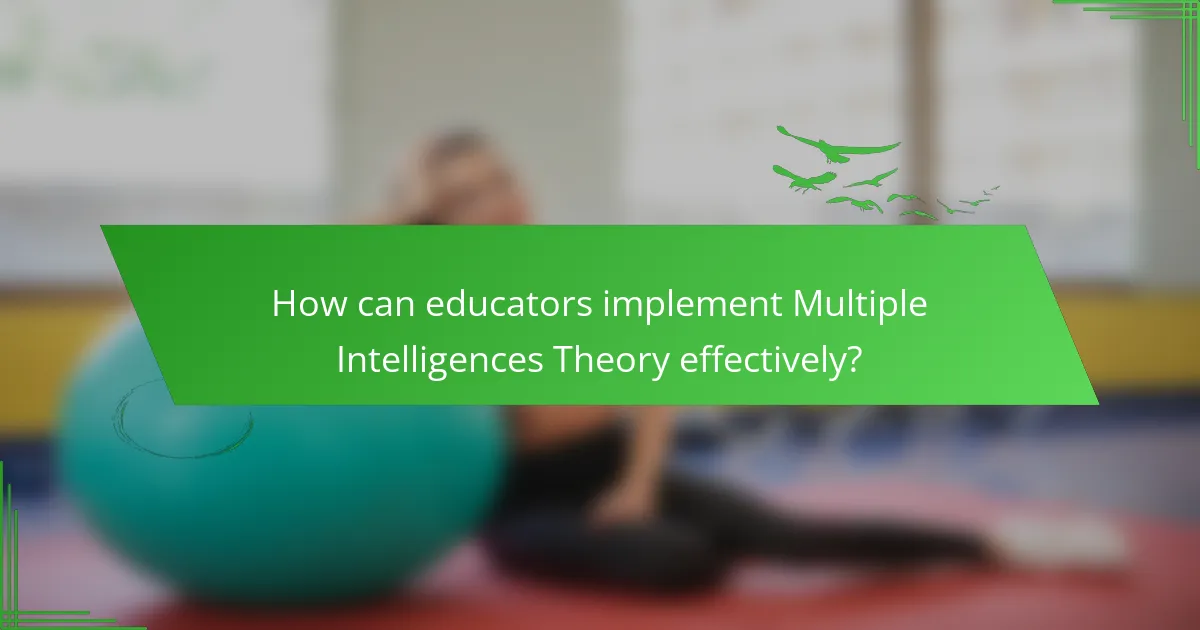
How can educators implement Multiple Intelligences Theory effectively?
Educators can implement Multiple Intelligences Theory effectively by tailoring instruction to diverse learning styles. This approach enhances student engagement and fosters a deeper understanding of material.
Strategies include using varied teaching methods such as visual aids, hands-on activities, and group discussions. Assessing students’ strengths through surveys or observations allows educators to adapt their lessons accordingly.
Incorporating project-based learning encourages students to explore their interests while developing critical thinking skills. Regular feedback helps refine these strategies, ensuring they meet individual learning needs.
Ultimately, recognising and valuing each student’s unique intelligence leads to a more inclusive and effective learning environment.
What are the best practices for assessing multiple intelligences in students?
To assess multiple intelligences in students effectively, educators should use diverse evaluation methods. These include observations, surveys, and performance tasks tailored to each intelligence type. Incorporating student interests and strengths into assessments enhances engagement and accuracy. Regular feedback and reflection sessions can help students understand their unique intelligences and learning preferences.
What common mistakes should educators avoid when applying Multiple Intelligences Theory?
Educators should avoid several common mistakes when applying Multiple Intelligences Theory. Failing to assess individual student strengths can lead to ineffective teaching strategies. Overemphasising one intelligence while neglecting others limits holistic development. Additionally, not integrating diverse learning activities may disengage students. Finally, disregarding ongoing assessment can hinder the adaptation of teaching methods to meet evolving student needs.
How can parents support their children’s multiple intelligences at home?
Parents can support their children’s multiple intelligences at home by providing diverse learning experiences. Engaging children in activities that cater to various intelligences fosters their growth. For instance, musical intelligence can be nurtured through singing or instrument lessons, while linguistic intelligence benefits from storytelling and reading together. Incorporating hands-on activities, such as science experiments for logical-mathematical intelligence, enhances understanding.
Additionally, creating a supportive environment that encourages exploration and curiosity is essential. Parents should observe their children’s interests and adapt learning opportunities accordingly. This personalised approach helps children thrive in their unique intelligences.

What are the future trends in Multiple Intelligences Theory?
The future trends in Multiple Intelligences Theory focus on personalised learning, technology integration, and interdisciplinary approaches. Educational systems are increasingly adopting tailored strategies to address diverse intelligence types. As technology evolves, tools that support varied learning styles will enhance engagement. Furthermore, interdisciplinary curricula will foster holistic development by connecting different intelligences in real-world contexts. These trends aim to create more inclusive and effective learning environments.
How might technology influence the application of Multiple Intelligences Theory in education?
Technology enhances the application of Multiple Intelligences Theory in education by providing diverse learning tools. Digital platforms enable personalised learning experiences, catering to various intelligences such as linguistic, logical-mathematical, and spatial. Interactive software and apps facilitate hands-on activities, promoting kinesthetic learning. Additionally, technology supports collaboration and communication among students, fostering interpersonal intelligence. The integration of multimedia resources also aids in engaging visual and auditory learners effectively. Overall, technology broadens the scope of teaching strategies aligned with Multiple Intelligences Theory.
What changes in educational policy could enhance the understanding of Multiple Intelligences Theory?
Educational policy changes that emphasise teacher training on Multiple Intelligences Theory can significantly enhance understanding. Integrating this theory into curricula fosters diverse learning strategies, catering to various intelligence types. Policies should promote interdisciplinary approaches that encourage collaboration among educators to share best practices. Additionally, implementing assessment methods that reflect multiple intelligences will provide a more holistic view of student capabilities. Providing resources and support for schools to adopt these strategies can lead to improved educational outcomes.
